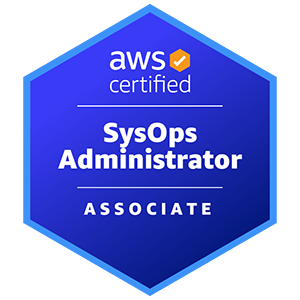Key Features

Training Mode
Classroom and Online

Learning Method
Lecture & Self-Study

Lecture & Self-Study
1 Month

Training Hours
3 Hours per day

Hands on Labs
Yes

Study Material
Yes

Certificate
Yes

Batches
(Mon-Thu) & (Sat-Sun)
AWS Certified SysOps Administrator Associate

The AWS Certified SysOps Administrator offers help to identify and develop talent with critical skills for implementing cloud initiatives. Earning AWS Certified SysOps Administrator – Associate demonstrates experience deploying, managing, and operating workloads on AWS.
It validates a candidate’s ability to complete the following tasks:
- Support and maintain AWS workloads according to the AWS Well-Architected Framework
- Perform operations by using the AWS Management Console and the AWS CLI
- Implement security controls to meet compliance requirements
- Monitor, log, and troubleshoot systems
- Apply networking concepts (for example, DNS, TCP/IP, firewalls)
- Implement architectural requirements (for example, high availability, performance, capacity)
- Perform business continuity and disaster recovery procedures
- Identify, classify, and remediate incidents
AWS Certified SysOps Administrator Associate
Course Duration
- 2 month of Instructor-led classroom training
- 2 month of instructor-led online training
Who should enroll ?
This certification is intended for candidates who has:
- 1–2 years of experience as a systems administrator in an operations role
- Experience in monitoring, logging, and troubleshooting
- Knowledge of networking concepts (for example, DNS, TCP/IP, firewalls)
- Ability to implement architectural requirements (for example, high availability, performance, capacity)
What you'll learn in this course?
- Your hands-on experience deploying, managing, and operating workloads on AWS as well as implementing security controls and compliance requirements
- Familiarity with using both the AWS Management Console and the AWS Command Line Interface (CLI)
- Understanding of the AWS Well-Architected Framework as well as AWS networking and security services
Devices during Hands-on Labs
Jobs?
- AWS SysOps Administrator
- AWS Admin
- Senior SysOps Administrator
- AWS Solutions Engineer
- Server Administrator
- DevOps Engineer
- AWS Cloud Admin
- Cloud Engineer
- AWS Architect
- AWS Certified Full Stack Engineer
Prerequisites
- Basic knowledge of virtualization technology
- Understanding of Linux and Windows: Shell scripting in Linux and PowerShell in Windows
- Basic knowledge of networking protocols such as HTTP and TCP/IP
- Proficiency in software development and administration
Introduction
The AWS Certified SysOps Administrator – Associate (SOA-C02) exam is intended for system administrators in a cloud operations role. The exam validates a candidate’s ability to deploy, manage, and operate workloads on AWS.
The exam also validates a candidate’s ability to complete the following tasks:
- Support and maintain AWS workloads according to the AWS Well-Architected Framework
- Perform operations by using the AWS Management Console and the AWS CLI
- Implement security controls to meet compliance requirements
- Monitor, log, and troubleshoot systems
- Apply networking concepts (for example, DNS, TCP/IP, firewalls)
- Implement architectural requirements (for example, high availability, performance, capacity)
- Perform business continuity and disaster recovery procedures
- Identify, classify, and remediate incidents
Training Outline
Domain
The target candidate should have 1 year of experience with deployment, management, networking, and security on AWS.
Recommended general IT knowledge
The target candidate should have the following knowledge:
- 1–2 years of experience as a systems administrator in an operations role
- Experience in monitoring, logging, and troubleshooting
- Knowledge of networking concepts (for example, DNS, TCP/IP, firewalls)
- Ability to implement architectural requirements (for example, high availability, performance, capacity)
Recommended AWS knowledge
The target candidate should have the following knowledge:
- Minimum of 1 year of hands-on experience with AWS technology
- Experience in deploying, managing, and operating workloads on AWS
- Understanding of the AWS Well-Architected Framework
- Hands-on experience with the AWS Management Console and the AWS CLI
- Understanding of AWS networking and security services
- Hands-on experience in implementing security controls and compliance requirements
What is considered out of scope for the target candidate?
The following is a non-exhaustive list of related job tasks that the target candidate is not expected to beable to perform. These items are considered out of scope for the exam:
- Design distributed architectures
- Design continuous integration and continuous delivery (CI/CD) pipelines
- Design hybrid and multi-VPC networking
- Develop software
- Define security, compliance, and governance requirements
For a detailed list of specific tools and technologies that might be covered on the exam, as well as lists of in-scope and out-of-scope AWS services, refer to the Appendix.
Response types
There are three types of questions on the exam:
- Multiple choice: Has one correct response and three incorrect responses
- Multiple response: Has two or more correct responses out of five or more response options
- Exam lab: Has a scenario that is composed of a set of tasks to perform in the AWS Management
- Console or AWS CLI
Multiple choice and multiple response: Select one or more responses that best complete the statement or answer the question. Distractors, or incorrect answers, are response options that a candidate with incomplete knowledge or skill might choose. Distractors are generally plausible responses that match the content area.
All multiple-choice and multiple-response questions will appear at the start of the exam in one section. The end of this section will include a review screen, where you can return to any of the multiple-choice and multiple-response questions. This will be the last opportunity to answer the questions or change any answer selections. If your exam contains exam labs, that section will appear after the multiple-choice and multiple-response section. You will NOT be able to go back to the first section after you start the second section.
Exam labs: Complete the required tasks for a given scenario in the AWS Management Console or AWS CLI in the provided AWS account. When you begin your exam, you will receive notification about the number of questions in the multiple-choice and multiple-response section, and the number of exam labs in the exam lab section. You will also learn the percentage of your score that will be determined by your work in the exam labs. Plan to leave 20 minutes to complete each exam lab.
Finish all work on an exam lab before you move to the next exam lab. You will NOT be able to return to a prior exam lab. You are welcome to use the virtual machine notepad or AWS CLI while working on your exam labs.
There might be more than one way to perform an exam lab. In those cases, you will receive full credit if you achieve the correct end state to the scenario. You will receive partial credit for partial completion of exam labs. However, exam content and the associated scoring are confidential, so you will receive no further information regarding partial credit that is awarded for an exam lab.
Tip: If you take your exam through online proctoring, you can use an external monitor as your ONLY display. Set your screen resolution to 1280 pixels x 1024 pixels or greater for a PC, and 1440 pixels x 900 pixels or greater for a Mac. Set the scaling to 100%. Other settings might result in a need to scroll within the console.
On the exam, unanswered questions are scored as incorrect; there is no penalty for guessing. The exam includes 50 questions that affect your score. These questions include multiple-choice questions, multiple-response questions, and exam labs. Each scored multiple-choice question and each scored multiple-response question counts as a single scored opportunity. A scored exam lab includes multiplescored opportunities.
For a sample of the multiple-choice and multiple-response questions and exam labs, see AWS Certified SysOps Administrator – Associate (SOA-C02) Sample Exam Questions.
Unscored content
The exam includes 15 unscored questions that do not affect your score. AWS collects information about candidate performance on these unscored questions to evaluate these questions for future use as scored questions. These unscored questions are not identified on the exam.
The AWS Certified SysOps Administrator – Associate (SOA-C02) exam is a pass or fail exam. The exam is scored against a minimum standard established by AWS professionals who follow certification industry best practices and guidelines.
Your results for the exam are reported as a scaled score of 100–1,000. The minimum passing score is 720. Your score shows how you performed on the exam as a whole and whether or not you passed. Scaled scoring models help equate scores across multiple exam forms that might have slightly different difficulty levels.
Your score report may contain a table of classifications of your performance at each section level. This information is intended to provide general feedback about your exam performance. The exam uses a compensatory scoring model, which means that you do not need to achieve a passing score in each section. You need to pass only the overall exam.
Each section of the exam has a specific weighting, so some sections have more questions than other sections have. The table contains general information that highlights your strengths and weaknesses. Use caution when interpreting section-level feedback.
This exam guide includes weightings, test domains, and objectives for the exam. It is not a comprehensive listing of the content on the exam. However, additional context for each of the objectives is available to help guide your preparation for the exam. The following table lists the main content domains and their weightings. The table precedes the complete exam content outline, which includes the additional context. The percentage in each domain represents only scored content.
| Domain | % of Exam |
| Domain 1: Monitoring, Logging, and Remediation | 20% |
| Domain 2: Reliability and Business Continuity | 16% |
| Domain 3: Deployment, Provisioning, and Automation | 18% |
| Domain 4: Security and Compliance | 16% |
| Domain 5: Networking and Content Delivery | 18% |
| Domain 6: Cost and Performance Optimization | 12% |
| Total | 100% |
1.1 Implement metrics, alarms, and filters by using AWS monitoring and logging services
- Identify, collect, analyze, and export logs (for example, Amazon CloudWatch Logs, CloudWatch
- Logs Insights, AWS CloudTrail logs)
- Collect metrics and logs using the CloudWatch agent
- Create CloudWatch alarms
- Create metric filters
- Create CloudWatch dashboards
- Configure notifications (for example, Amazon Simple Notification Service [Amazon SNS],
- Service Quotas, CloudWatch alarms, AWS Health events)
1.2 Remediate issues based on monitoring and availability metrics
Create and maintain AWS Auto Scaling plans
- Troubleshoot or take corrective actions based on notifications and alarms
- Configure Amazon EventBridge rules to trigger actions
- Use AWS Systems Manager Automation documents to take action based on AWS Config rules
2.1 Implement scalability and elasticity
Create and maintain AWS Auto Scaling plans
- Implement caching
- Implement Amazon RDS replicas and Amazon Aurora Replicas
- Implement loosely coupled architectures
- Differentiate between horizontal scaling and vertical scaling
2.2 Implement high availability and resilient
- Configure Elastic Load Balancer and Amazon Route 53 health checks
- Differentiate between the use of a single Availability Zone and Multi-AZ deployments (for example, Amazon EC2 Auto Scaling groups, Elastic Load Balancing, Amazon FSx, Amazon RDS)
- Implement fault-tolerant workloads (for example, Amazon Elastic File System [Amazon EFS], Elastic IP addresses)
- Implement Route 53 routing policies (for example, failover, weighted, latency based) environments
2.3 Implement backup and restore strategies
- Automate snapshots and backups based on use cases (for example, RDS snapshots, AWS
- Backup, RTO and RPO, Amazon Data Lifecycle Manager, retention policy)
- Restore databases (for example, point-in-time restore, promote read replica)
- Implement versioning and lifecycle rules
- Configure Amazon S3 Cross-Region Replication
- Execute disaster recovery procedures
3.1 Provision and maintain cloud resources
- Create and manage AMIs (for example, EC2 Image Builder)
- Create, manage, and troubleshoot AWS CloudFormation
- Provision resources across multiple AWS Regions and accounts (for example, AWS Resource
- Access Manager, CloudFormation StackSets, IAM cross-account roles)
- Select deployment scenarios and services (for example, blue/green, rolling, canary)
- Identify and remediate deployment issues (for example, service quotas, subnet sizing,
- CloudFormation and AWS OpsWorks errors, permissions)
3.2 Automate manual or repeatable processes
- Use AWS services (for example, OpsWorks, Systems Manager, CloudFormation) to automate deployment processes
- Implement automated patch management
- Schedule automated tasks by using AWS services (for example, EventBridge, AWS Config)
4.1 Implement and manage security and compliance policies
Implement IAM features (for example, password policies, MFA, roles, SAML, federated identity, resource policies, policy conditions)
- Troubleshoot and audit access issues by using AWS services (for example, CloudTrail, IAM
- Access Analyzer, IAM policy simulator)
- Validate service control policies and permissions boundaries
- Review AWS Trusted Advisor security checks
- Validate AWS Region and service selections based on compliance requirements
- Implement secure multi-account strategies (for example, AWS Control Tower, AWS Organizations)
4.2 Implement data and infrastructure protection strategies
- Enforce a data classification scheme
- Create, manage, and protect encryption keys
- Implement encryption at rest (for example, AWS Key Management Service [AWS KMS])
- Implement encryption in transit (for example, AWS Certificate Manager, VPN)
- Securely store secrets by using AWS services (for example, AWS Secrets Manager, Systems Manager Parameter Store)
- Review reports or findings (for example, AWS Security Hub, Amazon GuardDuty, AWS Config, Amazon Inspector)
5.1 Implement networking features and connectivity
- Configure a VPC (for example, subnets, route tables, network ACLs, security groups, NAT gateway, internet gateway)
- Configure private connectivity (for example, Systems Manager Session Manager, VPC endpoints, VPC peering, VPN)
- Configure AWS network protection services (for example, AWS WAF, AWS Shield)
5.2 Configure domains, DNS services, and content delivery
- Configure Route 53 hosted zones and records
- Implement Route 53 routing policies (for example, geolocation, geoproximity)
- Configure DNS (for example, Route 53 Resolver)
- Configure Amazon CloudFront and S3 origin access identity (OAI)
- Configure S3 static website hosting
- 5.3 Troubleshoot network connectivity issues
- Interpret VPC configurations (for example, subnets, route tables, network ACLs, security groups)
- Collect and interpret logs (for example, VPC Flow Logs, Elastic Load Balancer access logs, AWS WAF web ACL logs, CloudFront logs)
- Identify and remediate CloudFront caching issues
- Troubleshoot hybrid and private connectivity issues
6.1 Implement cost optimization strategies
- Implement cost allocation tags
- Identify and remediate underutilized or unused resources by using AWS services and tools (for example, Trusted Advisor, AWS Compute Optimizer, Cost Explorer)
- Configure AWS Budgets and billing alarms
- Assess resource usage patterns to qualify workloads for EC2 Spot Instances
- Identify opportunities to use managed services (for example, Amazon RDS, AWS Fargate, EFS)
6.2 Implement performance optimization strategies
- Recommend compute resources based on performance metrics
- Monitor Amazon EBS metrics and modify configuration to increase performance efficiency
- Implement S3 performance features (for example, S3 Transfer Acceleration, multipart uploads)
- Monitor RDS metrics and modify the configuration to increase performance efficiency (for example, Performance Insights, RDS Proxy)
- Enable enhanced EC2 capabilities (for example, enhanced network adapter, instance store, placement groups)
- Which key tools, technologies, and concepts might be covered on the exam?
The following is a non-exhaustive list of the tools and technologies that could appear on the exam. This list is subject to change and is provided to help you understand the general scope of services, features, or technologies on the exam. The general tools and technologies in this list appear in no particular order. AWS services are grouped according to their primary functions. While some of these technologies will likely be covered more than others on the exam, the order and placement of them in this list is no indication of relative weight or importance:
- Analytics
- Application Integration
- AWS Cost Management
- Compute
- Containers
- Database
- Management, Monitoring, and Governance
- Migration and Transfer
- Networking and Content Delivery
- Security, Identity, and Compliance
- Storage
AWS services and features
Analytics:
- Amazon Elasticsearch Service (Amazon ES)
Application Integration:
- Amazon EventBridge (Amazon CloudWatch Events)
- Amazon Simple Notification Service (Amazon SNS)
- Amazon Simple Queue Service (Amazon SQS)
AWS Cost Management:
- AWS Cost and Usage Report
- AWS Cost Explorer
- Savings Plans
Compute:
- AWS Application Auto Scaling
- Amazon EC2
- Amazon EC2 Auto Scaling
- Amazon EC2 Image Builder
- AWS Lambda
Database:
- Amazon Aurora
- Amazon ElastiCache
- Amazon RDS
Management, Monitoring, and Governance:
- AWS CloudFormation
- AWS CloudTrail
- Amazon CloudWatch
- AWS Command Line Interface (AWS CLI)
- AWS Compute Optimizer
- AWS Config
- AWS Control Tower
- AWS License Manager
- AWS Management Console
- AWS OpsWorks
- AWS Organizations
- AWS Personal Health Dashboard
- AWS Secrets Manager
- AWS Service Catalog
- AWS Systems Manager
- AWS Systems Manager Parameter Store
- AWS tools and SDKs
- AWS Trusted Advisor
Migration and Transfer:
- AWS DataSync
- AWS Transfer Family
Networking and Content Delivery:
- AWS Client VPN
- Amazon CloudFront
- Elastic Load Balancing
- AWS Firewall Manager
- AWS Global Accelerator
- Amazon Route 53
- Amazon Route 53 Resolver
- AWS Transit Gateway
- Amazon VPC
- Amazon VPC Traffic Mirroring
Security, Identity, and Compliance:
- AWS Certificate Manager (ACM)
- Amazon Detective
- AWS Directory Service
- Amazon GuardDuty
- AWS IAM Access Analyzer
- AWS Identity and Access Management (IAM)
- Amazon Inspector
- AWS Key Management Service (AWS KMS)
- AWS License Manager
- AWS Secrets Manager
- AWS Security Hub
- AWS Shield
- AWS WAF
- Storage:
- Amazon Elastic Block Store (Amazon EBS)
- Amazon Elastic File System (Amazon EFS)
- Amazon FSx
- Amazon S3
- Amazon S3 Glacier
- AWS Backup
- AWS Storage Gateway
Out-of-scope AWS services and features
The following is a non-exhaustive list of AWS services and features that are not covered on the exam. These services and features do not represent every AWS offering that is excluded from the exam content. Services or features that are entirely unrelated to the target job roles for the exam are excluded from this list because they are assumed to be irrelevant.
Out-of-scope AWS services and features include the following:
- Amazon API Gateway
- Amazon AppStream 2.0
- AWS Batch
- Amazon Chime
- Amazon Cloud Directory
- Amazon CloudSearch
- AWS CodeBuild
- AWS CodeCommit
- AWS CodeDeploy
- AWS CodeStar
- Amazon Connect
- AWS Deep Learning AMIs (DLAMI)
- AWS Device Farm
- Amazon DynamoDB
- Amazon DynamoDB Accelerator (DAX)
- Amazon Elastic Container Registry (Amazon ECR)
- Amazon Elastic Container Service (Amazon ECS)
- Amazon Elastic Transcoder
- Amazon EMR
- Amazon GameLift
- AWS IoT Button
- AWS IoT Greengrass
- AWS IoT Platform
- Amazon Kinesis
- Amazon Lex
- Amazon Lightsail
- Amazon Lumberyard
- Amazon Machine Learning (Amazon ML)
- AWS Managed Services
- AWS Mobile Hub
- AWS Mobile SDK
- Apache MXNet on AWS
- Amazon Pinpoint
- Amazon Polly
- Amazon Redshift
- Amazon Rekognition
- AWS Schema Conversion Tool
- Amazon Simple Email Service (Amazon SES)
- AWS Snowmobile
- Amazon WorkDocs
- Amazon WorkMail
- Amazon WorkSpaces
- AWS X-Ray
Do you provide Placement Assistance, post completion of the training?
We are 100% committed to offer placement assistance to our students. Industry approved Resume Templates are provided to candidates as guidance to assist them in writing their resumes. We also provide students with FAQ interview questionnaire to help them prepare for their job interviews.
What is expected salary after AWS Certified Cloud Practitioner Training Course?
On an average a AWS Solutions Architect – Associate with 3-5 years of experience gets salary in the range of INR 75,000 to 80,000 per month in India
After AWS Certified Cloud Practitioner training course, what is the Next Step?
Learning never stops. We always recommend AWS-Certified-Solutions-Architect-Associate (Course link) training. There is huge demand for AWS Certified Solutions Architect Professionals in market. These training and certification will establish your authority as an industry expert and provide you better career opportunities in the market.
Exam & Training
| Exam Name | Exam Code | Duration | Cost | Registration |
| AWS Certified SysOps | SOA-C01 | 2 Hours | 150 USD | Pearson VUE |
AWS Certified SysOps Administrator Associate

CCIE EI #66320

CCIE EI #26059

CCIE EI #66999

CCIE EI #51924

CCIE EI #50138

CCIE #50724

CCIE #49847
Start your CCNA journey
Review
Use the exam topics to evaluate what you already know, identify areas of focus, and build your
study plan.
Study and train
Once you know which topics your exam will cover, choose a study or training option that works
for you.
Practice
Practice with our labs, simulation tools.
Assess
Test your readiness with official CCNA practice questions.
Schedule test
Schedule to take your CCNA exam online or at a Pearson VUE location available worldwide.
Certify
Log in to the Certification Tracking System to see your updated status and claim your digital kit.
If this was your final certification exam, congratulations! It’s time to celebrate and tell the world about your accomplishment.
Recertify
Keep your certification current and your skills sharp with Continuing Education.
CCIE Service Provider Success Stories
Morbi id ipsum auctor nisl trum aliquet a sit amet nibh
AWS Certified SysOps Administrator Associate Success Stories
Completed my AWS Training course - AWS Certified Solutions Architect Associate with Mumbai Networks, and it was an incredibly valuable experience. The course was comprehensive, covering all the necessary topics to get up and running with AWS. The instructors were knowledgeable and extremely helpful, and they made sure to provide plenty of practical examples and hands-on exercises. All the necessary materials were provided and the course was easy to follow. Overall, I highly recommend this course with Mumbai Networks to anyone looking to get started with AWS.
I recently took a AWS course with Mumbai Networks Training (AWS Certified DevOps Engineer Professional) and I was very pleased with the quality of the material and the level of expertise provided. The course was comprehensive and covered a wide range of topics that were essential for understanding the fundamentals of networking. The instructor was highly knowledgeable and provided practical insight that was applicable to my daily job. I highly recommend Network Training for anyone looking for a comprehensive and well-structured training program.
I recently completed the AWS Certified SysOps Administrator Associate Training course with Mumbai Networks and found it to be an incredibly helpful and informative experience. The course was well organized and easy to understand, and I felt that the instructors did an excellent job of explaining the concepts and principles of AWS. The course provided me with a solid foundation of knowledge that I can use to further my development in the cloud. I was able to get a lot of hands-on experience and was pleased with the quality of the content from Mumbai Networks team. I would highly recommend Mumbai Networks to anyone looking to start their cloud journey. AWS Training is a great way to get the most out of your cloud experience.
Recently took the AWS Training course with Mumbai Networks and it was an absolute pleasure. The instructor was very knowledgeable and had a great deal of experience in the AWS platform. The course material was easy to understand and follow, and the course was well-structured and very informative. The material was also up to date with the latest AWS tools and technologies, which made it easier to apply my new knowledge. I highly recommend this course to anyone looking to learn more about the AWS platform and its capabilities.
Had the opportunity to take an AWS Training course with Mumbai Networks, and I must say that I was incredibly impressed with the level of knowledge and professionalism of the instructors. The course material was comprehensive and up-to-date with the latest AWS technologies and best practices, and the instructors were always available to answer any questions I had. I learned a great deal during my time in the course, and I would highly recommend Mumbai Networks AWS Training to anyone looking to learn more about the world of cloud computing.
Attended an AWS Cloud Practitioner course from Mumbai Networks and I was very impressed with the quality and depth of the content. The instructor was very knowledgeable and the course materials were comprehensive and up-to-date. I learned a lot about the various AWS products and services, and the course gave me a good starting point to develop my understanding further. Overall, I highly recommend AWS Training for anyone looking to learn more about the AWS platform.
I recently took the AWS Training course with Mumbai Networks and I highly recommend it. The course was comprehensive and the instructor was knowledgeable and very helpful. The lectures were easy to understand and the interactive labs enabled me to practice my skills. The course provided me with the necessary tools and knowledge to become AWS certified. There was also a great support team available for any questions or doubts. Overall, I had a great experience and would definitely recommend Mumbai Networks AWS Training to anyone looking to learn more about AWS.
FAQ on AWS Certified SysOps Administrator Associate
The AWS Certified SysOps Administrator Associate Certification is the associate level certification which opens the doors of opportunities in the industry by improving the chances of getting hired by global companies. Successful completion of prestigious AWS Certified SysOps Administrator Associate Training and Certification enhances your job profile. It also validates participant’s proficiency to effectively demonstrate knowledge of how to architect and deploy secure and robust applications on AWS technologies
Yes, we do have a group and corporate discount packages for classroom training programs. Please get in touch with us at [email protected] to know more about group discounts.
AWS certifications are valid for three years. Recertification helps strengthen the overall value of AWS certification. Recertification validates the consistency and interest levels of an individual to the employers. It also validates his credentials covering the latest knowledge of AWS cloud solutions and products.










